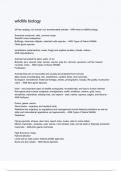wildlife biology
all free ranging, non human non domesticated animals - ANS-what is wildlife biology
American woodcock, rails, common snipe.
Sandhill crane subspecies
Bullfrogs, American alligator, selected turtle species. - ANS-Types of Game Wildlife
Other game species
amphibians (salamanders, toads, frogs) and reptiles (snakes, lizards, turtles). -
ANS-Herpetofauna
Animals harvested for skins, pelts, or fur.
Bobcats, lynx, skunks, otter, wolves, coyote, gray fox, raccoon, opossum, red fox, beaver,
muskrat, nutria. - ANS-Types of Game Wildlife
Furbearers
Animals that are not harvested and usually are protected from harvest.
May include invertebrates, fish, amphibians, reptiles, birds, and mammals.
Ecological, recreational, historical heritage, artistic, photographic, beauty, life quality, ecotourism
value. - ANS-Non-game Species
birds - very important class of wildlife ecologically, recreationally, and due to human interest.
Non-game birds include songbirds, woodpeckers, swifts, swallows, martins, gulls, terns,
shorebirds, waterbirds, wading birds, and raptors - owls, hawks, ospreys, eagles, and falcons. -
ANS-Avifauna
Ducks, geese, swans.
Wood ducks - migratory and resident birds.
Waterfowl are migratory so regulations and management include federal jurisdiction as well as
state and international regulations and agreements. - ANS-Types of Game Wildlife
Waterfowl
Flying squirrels, shrews, deer mice, beach mice, moles, otter in some states.
Marine mammals - porpoise, seal, walrus, most whales, bats, and all state or federally protected
mammals. - ANS-Non-game mammals
High Economic Value.
Harvest allowed.
Limits set by state and/or federal wildlife agencies.
Some are pen raised. - ANS-Game Species




